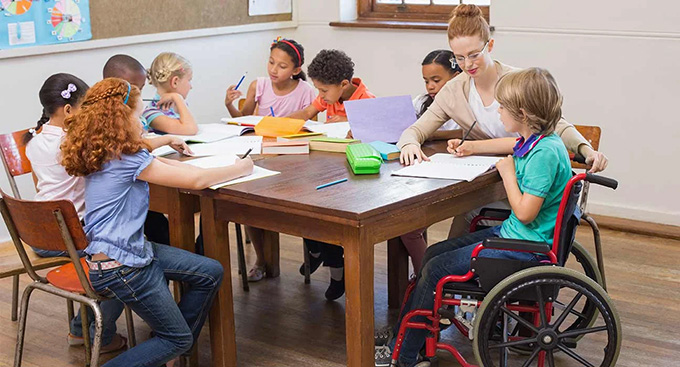
The Indonesian government’s commitment to implementing inclusive education is reflected in the increase in the number of inclusive schools from 28,778 in 2021 to 40,164 in 2023.
Inclusive education means all children are in the same classroom and school —not just children with disabilities but also minority language speakers and others.
However, this increasing number is not accompanied by solutions to the challenges of implementing inclusive education. One of them is the deficit of special assistant teachers (GPK) which has an impact on the suboptimal support for students with additional needs in regular schools whose numbers are increasing every year .
However, this increasing number is not accompanied by solutions to the challenges of implementing inclusive education. One of them is the deficit of special assistant teachers (GPK) which has an impact on the suboptimal support for students with additional needs in regular schools whose numbers are increasing every year .
In addition to a positive attitude, teachers also need to have high self-confidence and optimism in teaching students with diverse needs. Teachers with high efficacy towards inclusive education tend to have a strong desire/motivation in implementing inclusive teaching .
In addition, high efficacy can encourage teachers to be creative in carrying out teaching reforms , prevent teachers from experiencing burnout or mental fatigue and help teachers reduce emotional exhaustion .
This means that teachers are said to be ready to implement inclusive education if they have a positive attitude, see obstacles as challenges to develop themselves, and have high confidence in implementing inclusive education practices.
Inclusive education as a standard competency
Teacher education plays a vital role in equipping future educators with essential knowledge and skills. This program is an ideal pathway to integrate teacher preparation for inclusive education .
In addition to ensuring teacher readiness to meet the needs of diverse students from the start, the integration of inclusive education into teacher education programs also normalizes inclusive education as a standard teacher competency.
Various studies have reported that the implementation of inclusive education courses in teacher education programs is effective in improving teacher readiness . This is indicated by increased positive attitudes, decreased anxiety, and increased efficacy in implementing inclusive education.
To implement inclusive pedagogy effectively , there are three main targets for teacher education transformation, namely:
- Changing the perception from “special education” to “education for all” : Changing the perspective from education that focuses on certain groups to an approach that involves all students without exception.
- Believing that children’s abilities can develop: Eliminating the assumption that the presence of students with learning delays will hinder the progress of other students, and instead, believing that all children have the potential to develop.
- Seeing difficulties as challenges for teachers to grow: Seeing the difficulties faced by students as opportunities for teachers to grow and improve their practice, not as shortcomings in the students themselves.
Approach of taste, creation, will
The Heart, Head, Hands concept offers a holistic approach to designing inclusive teacher education programs. This concept was first proposed by Johann Heinrich Pestalozzi , a Swiss educator who believed that teaching and learning are an integration of the heart, head, and hand .
In the Indonesian context, Ki Hadjar Dewantara called these three things the tri sakti of the soul, namely feeling, creativity, and will .
Heart /feeling is related to teachers’ beliefs about inclusive education so that teachers need to develop positive attitudes towards inclusive education. Teacher education programs must foster positive beliefs in prospective teachers and help them see inclusive education as an opportunity to develop, not as a burden.
This belief can be achieved by teachers addressing their prejudices and addressing their concerns about inclusive education, and using culturally relevant approaches.
Head /creation refers to the cognitive and knowledge aspects of implementing inclusive education. Teacher education generally places more emphasis on types of disabilities, with little focus on inclusive teaching strategies. This emphasis on types of disabilities can increase prospective teachers’ concerns in implementing inclusive education . Prospective teachers need to be equipped with relevant knowledge, including good practices of inclusive education that have been implemented in schools , as well as materials on inclusive learning strategies such as cooperative learning, universal design learning, collaborative problem solving, heterogeneous grouping and effective teaching.
While hands /karsa include practical skills and direct application. Teacher education programs need to collaborate with schools as a place for teachers to demonstrate the knowledge they have gained in the classroom as well as mentors and examples of good practices in implementing inclusive education.
The application of the concept of feeling, creating, and intention in inclusive teacher education emphasizes the importance of collaboration between universities and schools to teach together, support, and assess the readiness of prospective teachers in facing inclusive classes .
In other words, inclusive teacher education requires a shared commitment. This can start by redefining education as a right for all children, then implementing it consistently to ensure meaningful and sustainable impact.
Author Bios: Pearl Subban is Associate Professor, Faculty of Education, Penny Round is Lecturer in Special Education and Umesh Sharma is Professor and Academic Head, Special Education and Educational Psychology all at Monash University
